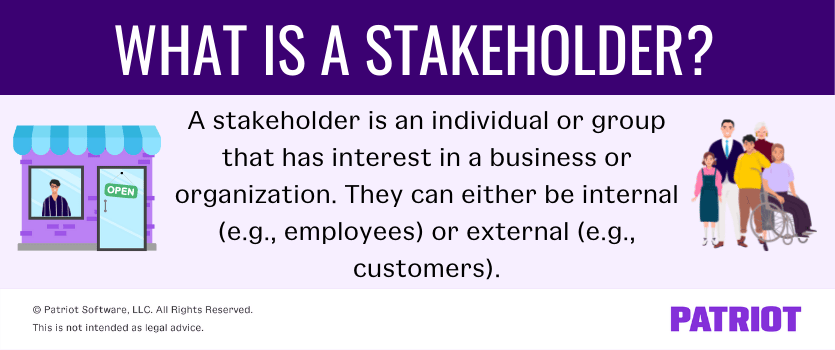Whether you know it or not, your business likely has a number of stakeholders. But, what are stakeholders? Keep reading, and we’ll give you the scoop on the stakeholder definition, types of stakeholders in business, and more.
Stakeholder definition
Who are stakeholders, exactly? A stakeholder is an individual or group that has interest in a business or organization. Stakeholders can either be affected by or affect a company’s or organization’s actions.
Depending on the situation, stakeholders can have a significant impact on the operational and financial decisions of a business. Some stakeholders may be more involved in the business, while others may not do anything other than engage with the business as needed.
Stakeholders can help a business or organization:
- Work toward achieving goals
- Meet strategic objectives
- Get necessary materials and resources
- Make smart business decisions
- Increase sales
- Find new areas for market penetration
Stakeholders vs. shareholders
Ever heard of shareholders? If you have, you may be wondering how they differ from stakeholders.
Shareholders are a very specific group of stakeholders who own shares in a business. But, not all stakeholders are shareholders. Shareholders may have additional responsibilities, like voting on business decisions and electing members. They can also sell their ownership in the company.
Stakeholders do not own shares of the business. Therefore, they do not have any ownership in the company. Instead, they are either directly or indirectly connected to the business in some shape or form (which we’ll get into next). They also may not be able to impact the business the way a shareholder can.
Different types of stakeholders
There are a variety of stakeholders, and they can all be broken down into two categories: internal or external.
Internal stakeholders
An internal stakeholder’s interest in a company comes through a direct relationship. Internal stakeholders are directly affected by a business’s activities or decisions.
Some examples of internal stakeholders include:
- Employees
- Managers
- Owners
External stakeholders
An external stakeholder does not directly work with a company. However, they are indirectly affected by the actions and decisions of a business.
Check out some examples of external stakeholders in business:
- Suppliers and vendors
- Customers
- Shareholders
- Creditors
- Governments
- Communities
- Investors
Who is not a stakeholder?
You know who stakeholders are now. But, who are not stakeholders in a company? Here are some examples of non-stakeholders:
- Competitors
- Disinterested people
- Other people who have no economic impact on the business

Stakeholder examples
Want to see some stakeholders in action? Check out a couple of examples of both internal and external stakeholders below.
Example 1: Internal stakeholders
When it comes to your business, your employees are internal stakeholders. Why? Because their employment is tied to the success of your company. Employees have a direct stake in your company because they earn an income along with other benefits. If the company doesn’t survive, the employees lose their income from the company.
Along with employees and managers, owners take risks in owning or running the business. In exchange, they hope to maximize business profits and their income.
Example 2: External stakeholders
Suppliers are an example of external stakeholders because a good portion of their revenue may come from a company. If your business were to change what it purchases or who it makes purchases from, it can impact suppliers and their revenue.
Another example of an external stakeholder is the government. The government collects taxes from your company (e.g., business income taxes) as well as from your employees (e.g., payroll taxes). They also collect tax from other spending, such as sales tax.
This is not intended as legal advice; for more information, please click here.







